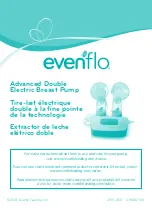
10
SAFETY RULES
When using electrical devices, special safety precautions must be taken including:
•
Observe the correct use of the appliance itself, as well as various accessories of the breast pump.
•
This appliance is not intended for use by persons (including children) with reduced physical, sensory or mental
capabilities, or lack of experience and knowledge, unless they have been given supervision or instruction
concerning use of the appliance by a person responsible for their safety.
•
Close supervision is necessary when any appliance is used by a disabled person or near children.
•
ALWAYS
keep the appliance out of the reach of children when not in use.
WARNING! FAILURE TO FOLLOW THE INSTRUCTIONS IN THIS MANUAL COULD CAUSE SERIOUS PERSONAL
INJURY, OR DAMAGE TO THIS EQUIPMENT.
1. The device should only be used in accordance with its intended use as described in this manual. Other uses
violate the terms of the warranty.
2. Check the device before each use. Do not use if the device is damaged in any way. Instead, contact the
manufacturer or distributor service.
3. It is forbidden to use the device while taking a bath.
4. DO NOT use any solvents or chemicals to clean the product.
5. The product is not a toy. Use and store the pump and all its parts out of the reach of children.
USEFUL HINTS
Important safety information:
•
Never use a breast pump during pregnancy because it may start a labour pains.
•
If you experience problems while breastfeeding, or feeding causes pain, it is necessary to seek medical advice,
before using the breast pump.
•
The first use of the breast pump is best to be done under the supervision of specialists.
•
It is recommended to read specialist literature and get to know the principles of baby feeding.
Before use, make sure that the pump has been disassembled, washed and disinfected.
Disassemble, wash and disinfect the breast pump components which come in contact with mother’s milk, always
before and after each use of the breast pump.
•
Ensure the overall purity of the product. Prevent the build-up of dust and other contaminants that may
adversely affect the work of the product.
•
Taking special care of hygiene is important to ensure the safety of mother and child.
When to use a breast pump?
If possible, wait until lactation stabilizes, which usually occurs within 2-4 weeks after birth.
Exceptions to this rule:
•
If your breasts produce too much milk, they become swollen and hard (engorged). Expressing a small amount of
milk before or during a feed can give you relief and help your baby to grasp the nipple.
•
If you have inverted nipples (which may occur because of long intervals between feeds).
•
If you have a concave, flat or damaged nipples (using a breast pump can improve nipple shape).
•
If you feel overflow between breastfeeds and do not want to wake the baby.
•
The baby is sick and does not want to suckle.
•
If your breasts produce too little milk. Using the pump between feeds will help increase milk production.
•
When you are working or away from home and want to continue breastfeeding, you should regularly express
milk using a breast pump to sustain the natural process of lactation.
How often should you express milk?
If mother cannot breastfeed temporarily it is recommended to express milk using breast pump at least 8 times for
every 24 hours. This will keep the lactation at the appropriate level. In the beginning you may experience difficulty
in expressing larger amount of milk, but after a few days you will be expressing more.
Also during stabilized lactation, possibility of single expression is smaller (30-60 ml), that is why collecting one
portion of milk may require several sessions.
Summary of Contents for EXPERT
Page 20: ...20 NOTES ...























